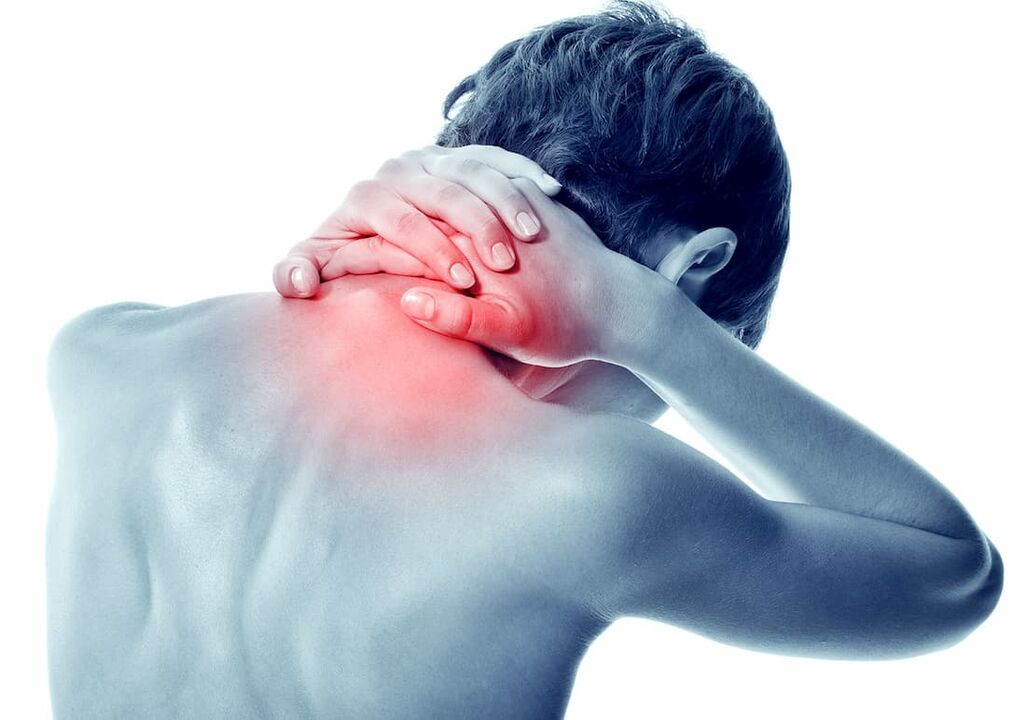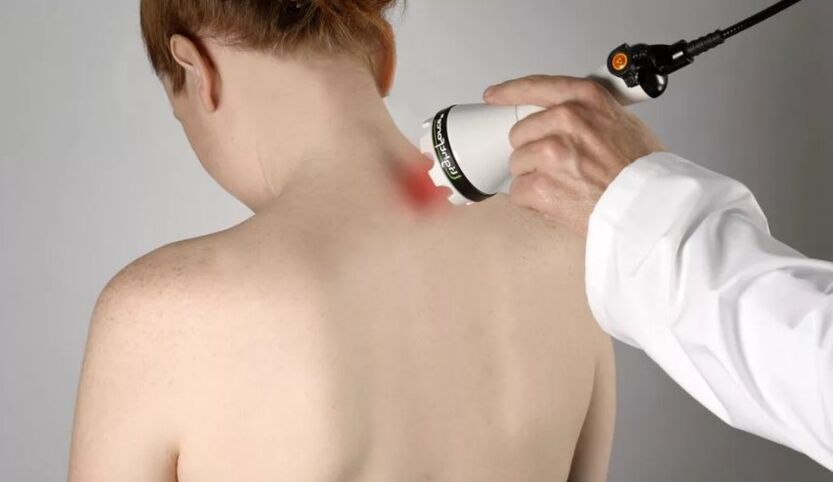
Cervical osteochondrosis is a chronic dystrophic disease in which the discs are larger, located between the vertebrae, followed by their bone tissue.As the degenerative process progresses, the surrounding structures are included.This is the reason for the development of a whole set of symptoms that completely subordinate the patient's life.
General information
The intervertebral discs consist of a nucleus with a gel and a tightly fibrous ring that surrounds it, covered with a layer of cartilage on top.They perform a shock absorption function, preventing damage to the vertebrae during running, walking and jumping, and also contribute to the mobility and flexibility of the entire spine.
In the process of natural aging, as well as in conditions of increased load, there is a gradual decrease in the height of the intervertebral disc.The metabolism in its core is impaired, cracks appear in the surrounding fibrous ring.Discs appear - convexity and hernia.With the progress of the disease, cartilage tissue and bones involve osteophytes - bone growth that causes the mobility and pronounced pain syndrome.
As the pathological changes occur in the immediate vicinity of the spinal cord and its roots, this leads to their compression and inflammation, as well as to the reflex development of muscle spasm.As a result, a person experiences characteristic symptoms through which the disease can be suspected.
Reasons
Osteochondrosis of the cervical spine refers to multifactorial diseases.It occurs against the background of a whole complex of factors, each of which exacerbates the influx of pathology.The reasons list includes:
- excess body weight;
- A sedentary lifestyle;
- Study work;
- Improper posture;
- Chronic diseases of the musculoskeletal system (scoliosis, flat legs), which contribute to the uneven distribution of the load on the spine;
- congenital pathologies of the development of the spine as well as injuries;
- excessive, repeated loads of the spine;
- Hereditary predisposition.
Symptoms and syndromes
Symptoms of cervical osteochondrosis do not appear immediately and are often concealed as other diseases.
The most common characters include:
- Dizziness: As a rule, with osteochondrosis, it is systemic, ie.It seems that the surrounding objects are spinning before his eyes;
- Pain in the area of the nape, neck, collar: its intensity depends on the degree of development of the disease;Light and episodic at an early stage, it spreads throughout the head and becomes permanent;The attacks periodically become unbearable, as a result of which a person cannot even move his head;
- Noise or ringing in the ears: occur when the position changes after a long period of immobility, often accompanied by dizziness;
- A sense of lack of air, the inability to absorb deep air;In severe cases, severe shortness of breath develops;
- Nausea and vomiting: are associated with blood disorders in certain areas of the brain, intensifying when trying to turn their heads;
- Reduction of vision, flickering flies or fog in front of the eyes: indicate insufficient supply of the blood of the brain;occur with advanced stages of the disease;
- fluctuations in blood pressure, slightly subject to drug correction;
- sudden fainting caused by spasm of blood vessels;
- The feeling of a lump in the throat, soreness, dryness, problems with swallowing: are often one of the first signs of pathology;
- pain in the shoulder joint;
- Tingling of the fingers.
In addition to the general signs of cervical osteochondrosis, several syndromes characteristic of the disease are distinguished.
Vertebrae syndrome
The complex of symptoms is associated with bone damage and cartilage of the spine.It includes:
- violation of mobility in the cervical region;
- head pain;
- X -ray signs of damage to the vertebrae and the space between them.
Vail Arttery Syndrome
The symptoms are caused by narrowing or spasm of the spinal arteries, which are partially responsible for the blood supply to the brain.It manifests itself with the following signs:
- tinnitus;
- dizziness;
- jumps in blood pressure;
- nausea and vomiting;
- headache;
- visual damage;
- reduction of productivity;
- drowsiness;
- Seizure.
Carden syndrome
It looks like a condition with damage to the heart muscle and includes:
- pain or burning sensation behind the sternum;
- weakness and fatigue;
- A quick pulse.
Rook syndrome
The condition is associated with damage (compression or pinching) of the nerve roots arising from the spine in the cervical area.Depending on the level of defeat, one may feel:
- numbness or pain in the back of the head;
- tongue numbness;
- Clavicle pain, difficulty in swallowing, hiccups;
- Discomfort in the shoulder area is enhanced by hand movements;
- soreness in the area of blades and forearms;
- tingling of the index and middle fingers;
- Tingling the ring and the little finger.
Most often, several nerve roots are involved in the pathological process at one time, resulting in several characteristic symptoms at once.
Stages
In the process of development, cervical osteochondrosis passes four consecutive stages (degrees), which determine the severity of the symptoms and the general condition of the patient.
- Stage 1.The thickness of the intervertebral discs is slightly reduced.Symptoms are practically absent, sometimes there is a slight neck discomfort, for example, with a long stay in the uncomfortable position.
- Stage 2. The height of the disk becomes even smaller, the pathological growth of cartilage tissue begins, a convexity (convexity) occurs.The pain becomes more severe, stiffness in the cervical region joins it.
- Stage 3. The fibrous ring around the core of the disc is torn, an intervertebral hernia is formed.The spine is noticeably deformed, the risk of dislocations and subluxation of the vertebrae increases.The pain becomes constant by nature, other symptoms of osteochondrosis join it.
- Stage 4.In the spine, irreversible changes occur: bone growth occurs, the intervertebral disc is replaced with a scar tissue and loses the ability to depreciate the load.The symptoms become pronounced and have a significant impact on the patient's lifestyle and his well -being.The quality of life is reduced.
Diagnostics
In search of the causes of pain or dizziness, the patient can contact doctors of various specialties: therapist, cardiologist, gastroenterologist, neurologist.In order to diagnose osteochondrosis, a comprehensive examination is required, which includes:
- X -ray and computed tomography are effective only in the late stages of the disease development when changes become clearly visible;
- Magnetic resonance imaging: due to a high degree of visualization even allows you to see even initial changes;Currently, this is the main method of diagnostics;
- Duplex scan of the arteries of the head and neck: allows you to evaluate the quality of blood flow, to identify the vessels of the vessels;It is used to determine the causes of headache and dizziness.
The compulsory examination and examination of the patient is evaluated, the determination of areas of pain and the degree of mobility of the spine, the quality of the reflexes is performed.Differential diagnosis with other diseases with similar symptoms can be prescribed:
- ECG, ultrasound of the heart;
- Daily ECG monitoring and blood pressure;
- X -Ray of the thoracic organs;
- Consultations of narrow specialists: cardiologist, Laura.
Treatment
The treatment of cervical osteochondrosis requires an integrated approach and includes:
- Medical effects;
- physiotherapy;
- Physiotherapy Physical Education;
- massage;
- Surgical treatment.
Medication
The main purpose of drug treatment: to relieve pain and dizziness, to restore the normal functioning of the nerve roots, and also, if possible, stop or slow the destruction of cartilage tissue.Depending on the situation, they are prescribed:
- Non -steroidal anti -inflammatory drugs: aimed at relieving pain and inflammation;They are used in the form of tablets, injections, ointments, plasters;
- Steroid medicines: also used to relieve inflammation with the ineffectiveness of NSAIDs;
- Missorelaxants: medicines that eliminate reflex muscle cramps, which causes the pain to reduce and blood circulation improves;
- In vitamins in the form of injection or tablet drugs: contribute to the improvement of nerve impulses;
- soothing with severe pain syndrome to improve sleep and reduce the emotional component of pain;
- Anti -refusing agents for pinching nerve roots;
- Chondroprotectors: Medicines that contribute to the repair of cartilage tissue.
Depending on the symptoms, medicines can also be prescribed to improve microcirculation in the vessels of the brain, medicines that block nausea and dizziness, etc.
Without medicine
Treatment methods that are not treatment are used outside the exacerbation.Depending on the clinical situation, they are used:
- Physiotherapy:
- laser therapy;
- magnetotherapy;
- UHF therapy;
- Phonophoresis and electrophoresis;
- massage;
- Physiotherapy Physical Education;
- acupuncture;
- Manual therapy;
- Underwater grip.
Improper treatment helps to reduce the severity of symptoms and reduce frequency and exacerbation.Acts indirectly:
- Improves the blood supply to the affected area, metabolism and regeneration processes;
- enhances the effect of drugs;
- Promotes to strengthen the muscle frame and stabilize the spine;
- Reduces the load of vertebrates;
- Eliminates muscle cramps and blocks.
Surgical treatment

The assistance for a surgeon is required in advanced cases of the disease when the drug methods are already ineffective.Several operations are currently being used:
- surgical removal of disc herniation (microdiscectomy, endoscopic or transfased surgery);
- Laminectomy: removal of spinically or arches of the vertebrae, which is why the load on the spinal cord of the spinal cord is reduced;
- Nucleoplasty: Elimination of hernia by removing part of the core of the intervertebral disc.
It is important to remember that only a doctor can decide how to treat osteochondrosis of the cervical spine.The scheme is drawn up individually, taking into account the stage of the disease accompanying pathologies and the individual characteristics of the patient's body.
Complications
Osteochondrosis causes a violation of the most important structures: blood vessels and nerves.Without treatment, the disease can lead to the following complications:
- ischemic stroke;
- loss of sensitivity or motor function of the hand;
- difficulty in swallowing;
- thyroid disorder;
- Loss or significant reduction in visual acuity.
In addition, the damage to the intervertebral discs and joints leads to a significant limitation of neck mobility.
Prevention
If you pay attention to the prevention of cervical osteochondrosis, even with existing changes, their progression will slow down significantly.Doctors recommend:
- Lead an active lifestyle, prevent hypodynamia;
- minimize or exclude weight;
- sleep on an orthopedic mattress and pillow;
- Warm up regularly if necessary for long -term work on your computer.
The perfect sport for osteochondrosis is swimming.The water unloads the spine and the active movements contribute to the formation of the muscle frame.


















